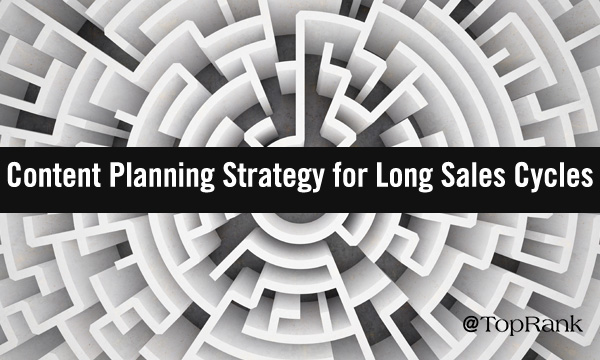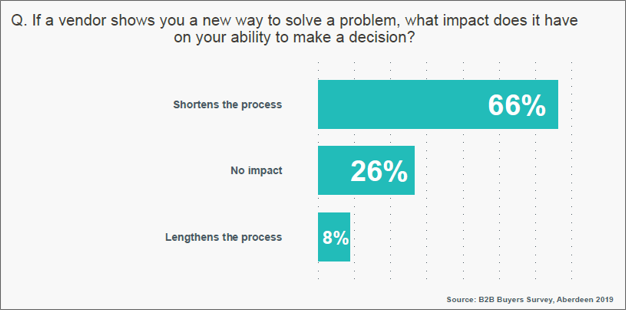
 In the world of consumer goods, purchase decisions are often made instantaneously and on a whim. “This blouse is exactly my style! I’ve gotta have it!” “I’ve been wanting a PlayStation 4 forever. Finally it’s mine!” “This tent is just what we were looking for. I don’t even need to ask the wife, I’m buying it now.” Even large, life-changing purchases can sometimes be triggered in a snap. “This car is perfect for me. I was going to check out a few other dealerships but no need; I’ll take it!” Of course, in B2B, this is rarely the case. Recently, we discussed the expanding nature of today’s buying committee, which is part of the reason business purchase journeys are only growing longer. Recent data suggests that 75% of sales cycles for new customers run at least four months, with almost half (46%) taking seven months or more. And since this is based on overall aggregated data, it’s safe to say that larger organizations and enterprises are more likely to fall on the top end of that range and beyond. Of course, such high-value prospective customers are generally the most coveted for providers of B2B solutions, so being able to engage and persuade these buyers (and committees) over time — not to mention accelerate this process — is of the essence for B2B content marketers. So, let’s examine some content planning steps you can take to do so effectively in the current B2B marketing landscape.
In the world of consumer goods, purchase decisions are often made instantaneously and on a whim. “This blouse is exactly my style! I’ve gotta have it!” “I’ve been wanting a PlayStation 4 forever. Finally it’s mine!” “This tent is just what we were looking for. I don’t even need to ask the wife, I’m buying it now.” Even large, life-changing purchases can sometimes be triggered in a snap. “This car is perfect for me. I was going to check out a few other dealerships but no need; I’ll take it!” Of course, in B2B, this is rarely the case. Recently, we discussed the expanding nature of today’s buying committee, which is part of the reason business purchase journeys are only growing longer. Recent data suggests that 75% of sales cycles for new customers run at least four months, with almost half (46%) taking seven months or more. And since this is based on overall aggregated data, it’s safe to say that larger organizations and enterprises are more likely to fall on the top end of that range and beyond. Of course, such high-value prospective customers are generally the most coveted for providers of B2B solutions, so being able to engage and persuade these buyers (and committees) over time — not to mention accelerate this process — is of the essence for B2B content marketers. So, let’s examine some content planning steps you can take to do so effectively in the current B2B marketing landscape.
Why Is the Sales Cycle Getting Longer?
Indecision appears to be the most common driver. New research from Aberdeen, featured in the report Why Do B2B Buyers Struggle? The Answer is in the Data, shows 53% of buyers saying they halt or postpone decisions on at least half of their B2B purchases. When asked why they’ve cancelled or postponed purchases, two-thirds of buyers called out lack of differentiation between solutions as the most typical cause. Another 57% say they decided no vendor meets their needs. How can content marketing play a role in overcoming these gridlocks, and the power of corporate inertia? When delays and stalling are unavoidable, how can you we make sure your brands stay top-of-mind rather than slipping by the wayside?
When asked why they’ve cancelled or postponed purchases, two-thirds of buyers called out lack of differentiation between solutions as the most typical cause. Another 57% say they decided no vendor meets their needs. How can content marketing play a role in overcoming these gridlocks, and the power of corporate inertia? When delays and stalling are unavoidable, how can you we make sure your brands stay top-of-mind rather than slipping by the wayside?
Counteracting Prolonged Sales Cycles with Content Planning
Selling to enterprise customers is a marathon, not a sprint. Becoming pushy or trying to force a decision will get you nowhere. However, the right strategic content planning can be pivotal in gently nudging a prospect toward your solution, as well as accelerating the process of making the call. Here are a few smart techniques to incorporate.Use an Always-On Approach
We need to keep buyers engaged throughout this extended cycle, and always-on marketing programs are the ticket. Rather than being encased in ephemeral campaigns, your marketing cadence is perpetually ongoing. You want prospects to be able to find and engage with your brand at any time throughout their lengthy consideration. As our Vice President of Client Accounts Alexis Hall wrote last year: “Campaigns can absolutely drive valuable spikes in traffic, engagement, or conversions, as well as help you target specific audiences or verticals. But you need to be able to nurture the audience you’ve built beyond the confines of the campaign—otherwise you’re not only wasting your budget, but also leaving longer-term value and opportunity on the table.” Longer buying cycles necessitate spreading out our content for maximum exposure and impact over time; always-on is designed for this purpose.Align Content with Buyer Stages
The customer journey is no longer a predictable linear path, but the old pillars — awareness, consideration, decision — remain viable as overarching guides. Is your content mapped to address each phase properly under the Attract, Engage, Convert framework? For instance: Awareness: Attract- Get your brand on the radar with easily discovered digital assets and insights
- Build trust with credible information, consistent output, and thought leadership
- Answer questions that tend to arise as customers are first recognizing their need
- Collaborate with a range of relevant influencers around important, trending topics or pain points within your niche to gain targeted visibility
- Use paid promotional tactics and remarketing to ensure key messaging connects with qualified prospects
- Generate content across various channels and formats to meet your customers where they’re at during self-driven research
- Analyze your competitors’ content strategies, and identify white space or opportunities to establish distinction
- Collaborate with prominent influencers around more specific topics relating to purchase decisions and solution differentiation
- Deploy your most compelling lower-funnel content (testimonials, case studies, ROI grids, etc.) to alleviate concerns or reservations
- Provide detailed pricing information and implementation specifics
- Collaborate with influencers such as current customers who are acutely familiar with your brand and solutions, and can speak to them authentically
- Free trials or demos can help an indecisive buyer take action
Gain Full Visibility within the Buying Committee
We’ve covered the key elements of a committee-centric approach, which requires researching the structure of an account, aligning with sales, and developing personas based on influencer roles within a buying committee. One of the biggest factors in slow or circular sales cycles is a group of decision makers who can’t get on the same page. Your content is instrumental in fostering a unified front.Plans Change: Stay Flexible and Nimble
Taking the right steps with content planning will help ensure you’re optimizing your strategy for long sales cycles (and, ideally, speeding them up). But the nature of enterprise organizations is that they are cumbersome and complex. Be ready for changes and make sure your plan is built to adapt when necessary. As a final note, I’ll point out that Abderdeen’s B2B buyer research indicates the best way to expedite decision-making is by showing prospects a new way to solve their problem. With this in mind, how can you continually work toward providing this unique and enlightening perspective through an always-on content marketing approach that accounts for numerous channels and formats, while also permeating the breadth of extended buying committees? It goes without saying that there’s tremendous value in shortening the sales cycle. While B2B purchase decisions — particularly at the enterprise level — will never be as snappy as choosing a pair of slacks, a robust content marketing plan will help buyers make their decision more quickly and confidently. Does your content marketing strategy account for the entire buying committee? Learn the difference between buyers and buying committees, as well as get steps for expanding your strategy to account for multiple purchasing influencers.
With this in mind, how can you continually work toward providing this unique and enlightening perspective through an always-on content marketing approach that accounts for numerous channels and formats, while also permeating the breadth of extended buying committees? It goes without saying that there’s tremendous value in shortening the sales cycle. While B2B purchase decisions — particularly at the enterprise level — will never be as snappy as choosing a pair of slacks, a robust content marketing plan will help buyers make their decision more quickly and confidently. Does your content marketing strategy account for the entire buying committee? Learn the difference between buyers and buying committees, as well as get steps for expanding your strategy to account for multiple purchasing influencers.
The post How to Educate, Engage, & Persuade Buyers Over Lengthy Sales Cycles appeared first on Online Marketing Blog - TopRank®.
Article Source: http://bathseoexpert.blogspot.com/2019/07/how-to-educate-engage-persuade-buyers.html
No comments:
Post a Comment